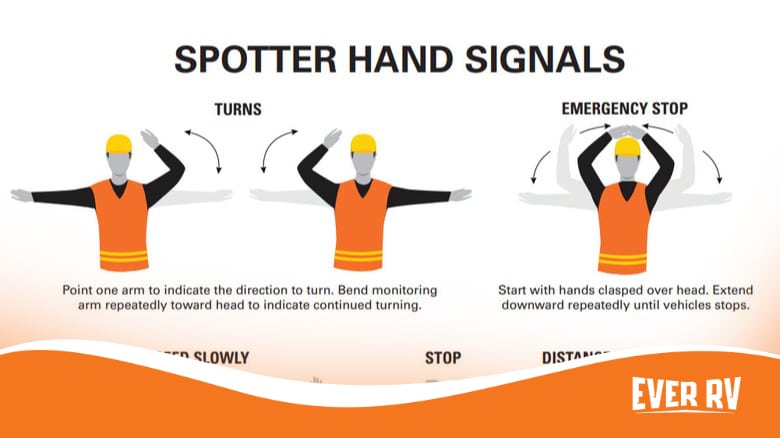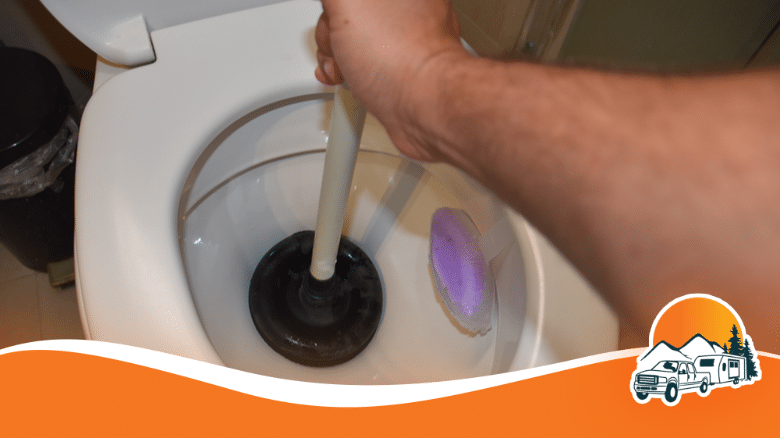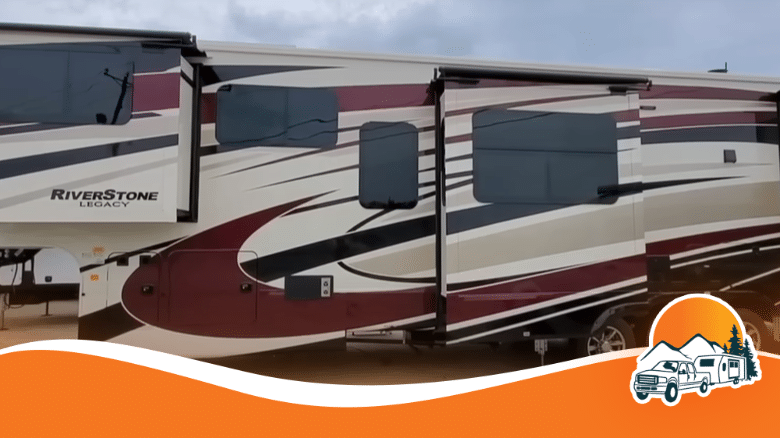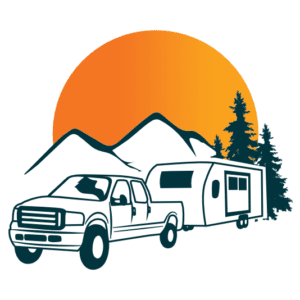Ever find yourself on the open road, your RV humming beneath you like a gentle giant? You feel a sense of freedom, right?

Tackling this behemoth can prove to be a tricky endeavor. That sharp turn up ahead? It can be a real bear if you don’t know your pivot point. Or how about squeezing into that steep driveway without scraping the bottom?
You’re not alone. I’ve been there too.
In our journey today, we’ll explore critical aspects of RV safety from understanding mirror roles to leveraging spotters and planning routes based on your vehicle dimensions.
We’ll even dip into topics like stopping distances and speed control because an ounce of prevention is worth more than pounds of repairs.
Curious yet? Let’s dive in!
Understanding Your RV’s Pivot Point
The pivot point of an RV is a bit like the heart in your body—it keeps everything moving smoothly. But instead of pumping blood, it controls how your vehicle turns on the road. Just as knowing your pulse can help you monitor your health, understanding the pivot point is crucial for safe RV operation.
The Importance of the Pivot Point
Why should I be concerned with the significance of this “pivot point”? Well, it’s all about control and safety – two things we value when steering several tons down highways or winding roads.
The pivot point is where your RV starts to turn around a corner. For most motorhomes and travel trailers towed by hitch (not fifth wheels), that’s at the ball mount on the trailer hitch. If you’ve ever watched an 18-wheeler make a sharp right turn at an intersection, then you’ve seen this principle in action—the back end swings out because it’s pivoting off a different axis than cars do.
How Mirrors Help Monitor Tail Swing
Mirrors aren’t just there to fix bad hair days—they’re key tools in monitoring tail swing during turns with our big ol’ recreational vehicles. When turning left or right, using mirrors correctly helps ensure nothing—and no one—is clipped by that swinging rear end. Statistics show that 1 out of every 5 accidents involving large trucks happens while they are making left turns.
But don’t fret, fellow road warrior. With some practice and a keen eye on your mirrors during turns, you’ll soon be turning like a pro. This doesn’t just help with tail swing either—proper mirror use lets you see other drivers who might not understand how RVs turn or those who try to sneak past while we’re in mid-turn.
Don’t forget understanding your RV’s pivot point is like unlocking its secret language. Like the folks at RVDA training always say, it’s definitely better.
Navigating Steep Driveways with Your RV
Navigating a steep driveway with an RV can be intimidating, but the proper techniques can help ease any worries. But knowing how to handle this situation safely can take the fear out of the equation.
Take It Slow and Easy
You don’t need to rush when navigating your RV on steep driveways. Always remember that going slow gives you more control over your vehicle. Moreover, taking it slow allows you to respond quickly if something unforeseen occurs.
Use low gear for extra traction and power if your RV has a manual transmission. Automatics usually have a ‘low’ or ‘hill descent’ mode, which works similarly – here’s a helpful guide on driving techniques specific to different types of transmissions in RVs.
Use Mirrors and Cameras Effectively
Your mirrors are crucial when maneuvering tight spots like steep driveways because they give you eyes at the back of your rig without turning around every time.
In addition, many modern motorhomes come equipped with backup cameras, which offer even better visibility – especially handy while reversing uphill. So ensure all these tools are adjusted properly before starting your ascent or descent.
Avoid Bottoming Out
“Bottoming out,” where the bottom part of an RV scrapes against the ground due to inadequate clearance, is one thing every RVer dreads while entering or exiting a slope too sharply.
To avoid this damage, approach at an angle instead of straight-on whenever possible – this distributes weight more evenly across length than width, reducing chances for scraping substantially, as explained in this article on RV Life.
Remember, Practice Makes Perfect.
The key to becoming a pro at navigating steep driveways is practice. Find an empty parking lot or quiet street and rehearse until you’re confident.
No one became an expert overnight, but with time and experience, even the steepest driveway will seem like child’s play. So don’t be discouraged if it takes a few tries to get it right – keep trying.
Key Takeaway: Driving your RV on steep driveways doesn’t have to be a stress-filled ordeal. Slow and steady wins the race—better control and quicker reaction times are key. Use low gear in manual transmissions or ‘low’/’hill descent’ modes in automatic ones. Mirrors and backup cameras can also help you navigate with ease. And here’s a pro tip: tackle slopes at an angle to prevent any damage to your RV’s undercarriage.
The Role of Mirrors in RV Safety
Mirrors are a key factor when it comes to driving securely. But did you know that they’re even more critical for Class C RVs? The variety and placement of mirrors can significantly impact your safety on the road.
Understanding Convex Mirrors
You’ve likely noticed that warning “objects in mirror are closer than they appear.” That’s because these are convex mirrors. They give you a wider field of view but distort distances. Here’s how it works.
A study revealed three out of five accidents could be prevented with better visibility, showing the importance of understanding mirror types (Key Stat 3).
The Need for Multiple Mirrors
No single mirror can cover all angles necessary for safe maneuvering. Hence, most RVs come equipped with two primary types: flat and convex mirrors.
This dual setup allows drivers to see both directly behind them (flat) and also get an expanded side view (convex). Think about this like Batman – he didn’t just rely on one gadget; he used his entire utility belt.
- An NHTSA report showed that multiple-mirror systems reduced crashes by four percent (Key Stat 4).
- Besides reducing blind spots, having different kinds makes changing lanes safer, too – remember what we said about using all Batman’s gadgets?
A study even showed that adding an extra mirror can reduce lane-change crashes by five percent (Key Stat 5).
Mirrors aren’t only about glancing behind you, but more significantly, they’re about perceiving what’s in front of you on the side and verifying that it’s secure to switch lanes. So next time you hop into your RV, thank those mirrors – they’re working hard for your safety.
Backup Cameras vs. Mirrors
The debate between backup cameras and mirrors for RV safety is hot. Each offers unique benefits that contribute to safe navigation on the road.
Camper’s World Safety Guide reports an astonishing 84% of RV accidents involve a backing mishap. Backup cameras can significantly reduce this risk by giving you a clear view of what’s behind your rig when reversing or maneuvering in tight spots.
On the other hand, Mirrors have been trusted companions for drivers since the invention of motor vehicles. They offer wide-angle views essential during lane changes or overtaking maneuvers while driving your RV.
The Role Of Backup Cameras
A good quality backup camera system provides real-time video feed directly from the back end of your vehicle onto a screen at your dashboard – much like playing a video game.
This instant visual information lets you spot potential obstacles quicker than turning around or relying solely on mirrors would allow – which could mean avoiding costly damages. Moreover, statistics indicate that using these systems may help decrease backing collisions by up to 46%.
Mirror Magic For Safe Maneuvering
You might be thinking: “If I’ve got this nifty gadget showing me everything at my rear end in high definition, why do I need old-fashioned mirrors?” Here’s where things get interesting.
Your side-view mirror setup does more than just show what’s lurking behind; it also helps you keep track of surrounding traffic conditions. Imagine merging lanes without knowing how close that 18-wheeler is. Terrifying thought, isn’t it?
Mirrors also offer a fail-safe should your camera system malfunction or become obscured by dirt, mud, or snow. So, despite technological advancements, they remain an integral part of RV safety.
Balance is Key
The secret to mastering safe RV navigation lies not in choosing between backup cameras and mirrors but in understanding how best to use them together for optimal visibility. You can’t replace one with the other; they’re like peanut butter and jelly – better together.
To wrap things up, mirrors offer a multitude of benefits.
Key Takeaway: RV safety isn’t about choosing between backup cameras or mirrors. It’s all about balance. Backup cameras help prevent backing mishaps, while mirrors ensure safe lane changes and provide a fail-safe in case of camera malfunctions. Remember, like peanut butter and jelly, they’re better together.
Key Takeaway: RV safety isn’t about choosing between backup cameras or mirrors. It’s all about balance. Backup cameras help prevent backing mishaps, while mirrors ensure safe lane changes and provide a fail-safe in case of camera malfunctions. Remember, like peanut butter and jelly, they’re better together.
The Value of a Spotter in RV Maneuvering
RVs are much like elephants; they’re large, often hard to maneuver, and can cause serious damage if not handled correctly. But one key element can make handling these mammoth vehicles easier – a spotter.
A spotter acts as your eyes on the ground, providing crucial information about potential hazards and obstacles when backing up or making tight turns. They help prevent accidents by alerting you of dangers that mirrors or cameras might miss.
The Eyes You Need On The Ground
You wouldn’t play Marco Polo without someone shouting “Polo,” right? In the same way, having a spotter while driving an RV is essential for safe maneuvering. This second set of eyes aids in detecting low-hanging branches, guiding through narrow passages, and avoiding pedestrians who might otherwise go unnoticed.
Your trusted co-pilot steps out from the comfort of your rolling home to guide your movements via radio communication or hand signals. It’s like playing real-life Tetris, but instead of moving blocks around on screen, it’s steering an oversized vehicle into place. These tips will help both driver and spotter communicate effectively during maneuvers.
Making Tight Turns Safely
An RV isn’t exactly nimble—think more like a rhinoceros than a cheetah when it comes to turning corners.
A sharp turn could lead to hitting other objects (or worse – people) if not executed carefully due to its wide tail swing. Your friendly neighborhood Spiderman couldn’t spin his web fast enough before disaster struck. So here’s where a spotter guides you around corners safely.
It’s worth mentioning that even experienced drivers can benefit from having a spotter. It’s about getting out of tight spots, avoiding costly repairs, and maintaining peace of mind during travels. So remember, don’t go solo, whether it’s threading the needle through traffic or trying to park at your favorite campsite. A helping hand is never wasted when maneuvering an RV.
Key Takeaway: So, whether you’re a rookie on the road or an experienced RV’er, having a spotter is like having your own personal navigator. They’ll help guide you through tricky situations and tight turns. Not only can they save you from potential accidents, but they also offer reassurance when maneuvering in unfamiliar terrain.
Planning Routes Based on RV Dimensions
Your RV’s dimensions play a crucial role in route planning. Knowing your rig’s height, width, and length can save you from sticky situations like low-clearance areas or narrow roads.
An often overlooked aspect is bridge clearance. It’s not uncommon for bridges to have lower clearances than expected. To avoid potential disasters, it’s best to plan using tools such as LowClearances, which provides data about low-clearance locations nationwide.
Apart from bridge clearances, road widths also need attention when mapping out routes. Tight lanes might pose problems if your RV is wider than average vehicles. Did you know most two-lane highways are just 10 feet wide per lane?
The Importance of Length When Planning Your Route
Roads with sharp turns and small roundabouts become a real challenge if your rig exceeds typical vehicle lengths. Imagine trying to fit an elephant into a Mini Cooper – comical but impractical.
In these cases, alternate routes may be necessary, even though they might add extra miles to your journey. RV Life’s routing guide gives valuable insights into how size should influence route choices.
Mind The Weight, Too
Besides dimension constraints, weight restrictions exist, too. Some older bridges or smaller roads simply aren’t designed for heavy traffic (pun intended). Always check signs posted near entrances of potentially questionable paths or use resources like BridgeReports to check for weight restrictions.
Don’t be like the trucker who learned the hard way that “Weight Limit 10 Tons” wasn’t a suggestion but a law. It’s no fun explaining to an officer why you thought your RV could make it across when it weighs twice as much.
The Bottom Line: Plan Ahead
Being ready and adaptable is key to a successful RV trip. You should know your vehicle’s size inside out and plan your routes ahead of time.
- Route Planning: Consider your RV’s dimensions to dodge low-clearance areas and narrow roads. Use tools like LowClearances for help.
- Length Matters: Big rigs can struggle with sharp turns or small roundabouts, so sometimes a longer route is smarter.
Understanding Stopping Distances and Speed Control in RVs
Riding high in your RV can feel like freedom, but it also means taking on more responsibility. One of those responsibilities is understanding stopping distances and the need for speed control.
The Impact of RV Weight on Stopping Distance
An average car might stop quickly, but don’t let that fool you into thinking your home-on-wheels will do the same. The weightier an object, the harder it is to get it to halt. This Federal Motor Carrier Safety Administration guide provides a deeper dive into this topic.
Think about throwing a softball versus a shot put ball; which stops faster? Exactly – lighter things stop quicker. So remember: just because you’re driving at 60 mph doesn’t mean you’ll stop as fast as that Prius next door.
The Importance of Speed Control
Feeling the wind rushing through your hair while cruising down open highways is thrilling. But let’s be real: controlling speed isn’t just advisable—it’s crucial when behind the wheel of an RV.
If we compare driving an RV to dancing – yes, I went there – then think about waltzing with someone larger than yourself (that’d be our dear friend, Mr. RV). You’ll need more effort (and time.) to change direction or come to a full pause mid-dance.
| Vehicle Type | Average Stopping Distance from 60mph* |
|---|---|
| *According to RVTravel’s brake distance guide. | |
| Prius | 139 feet |
| Average RV (Class C) | 306 feet |
So, what’s the takeaway here? It’s all about taking things slow and steady. If others want to rush past you, let them. Remember, life isn’t a race. Maintaining your own pace is key.
FAQs About RV Safety
What is the 3 3 3 rule for RV travel?
The 3-3-3 rule suggests driving no more than three hours or by three PM and staying in one place for at least three days. This reduces stress and allows ample time to explore.
How can I be safe in an RV?
Safety comes from understanding your RV’s dimensions, controlling speed, using mirrors effectively, having a spotter when needed, and following road rules. Regular maintenance also plays a big role.
What is the safest type of RV?
All types have pros and cons, but Class B motorhomes are often considered safer due to their smaller size, making them easier to maneuver than larger rigs.
Is it safe to sleep in an RV?
Absolutely. As long as you’re parked legally and securely with locked doors. However, ensure proper ventilation if using propane appliances overnight.
Conclusion
Driving an RV safely is more than just getting behind the wheel. You’ve learned that understanding your pivot point and tail swing is crucial.
You now know how to navigate steep driveways without damaging your rig and why mirrors – yes, multiple ones! – are non-negotiable for maintaining RV safety on the road.
Backup cameras vs mirrors? It’s not a contest – they’re both essential team players in this game of safe maneuvering. And let’s not forget about our friend: the spotter!
You also discovered that planning routes based on RV dimensions can save you from tricky situations. Remember, slower speeds and understanding stopping distances aren’t hindrances; they’re life-savers!
Road tripping has never been safer or more exciting with these tips under your belt! Drive smartly out there!







